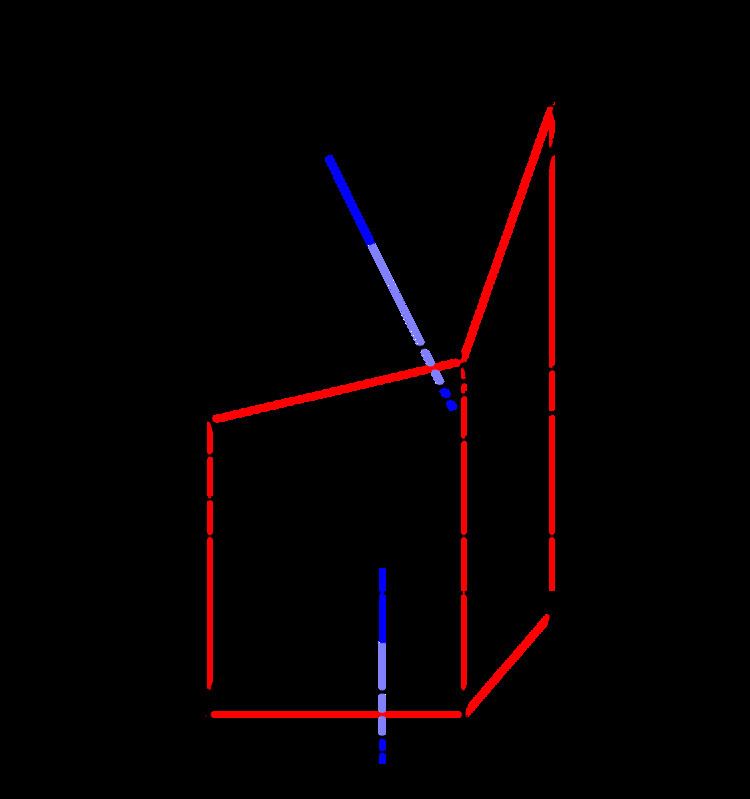 | ||
The Mindlin–Reissner theory of plates is an extension of Kirchhoff–Love plate theory that takes into account shear deformations through-the-thickness of a plate. The theory was proposed in 1951 by Raymond Mindlin. A similar, but not identical, theory had been proposed earlier by Eric Reissner in 1945. Both theories are intended for thick plates in which the normal to the mid-surface remains straight but not necessarily perpendicular to the mid-surface. The Mindlin–Reissner theory is used to calculate the deformations and stresses in a plate whose thickness is of the order of one tenth the planar dimensions while the Kirchhoff-Love theory is applicable to thinner plates.
Contents
- Mindlin theory
- Assumed displacement field
- Strain displacement relations
- Equilibrium equations
- Boundary conditions
- Stressstrain relations
- Mindlin theory for isotropic plates
- Constitutive relations
- Governing equations
- Relationship to Reissner theory
- Relationship to Kirchhoff Love theory
- References
The form of Mindlin–Reissner plate theory that is most commonly used is actually due to Mindlin and is more properly called Mindlin plate theory. The Reissner theory is slightly different. Both theories include in-plane shear strains and both are extensions of Kirchhoff-Love plate theory incorporating first-order shear effects.
Mindlin's theory assumes that there is a linear variation of displacement across the plate thickness but that the plate thickness does not change during deformation. An additional assumption is that the normal stress through the thickness is ignored; an assumption which is also called the plane stress condition. On the other hand, Reissner's theory assumes that the bending stress is linear while the shear stress is quadratic through the thickness of the plate. This leads to a situation where the displacement through-the-thickness is not necessarily linear and where the plate thickness may change during deformation. Therefore, Reissner's theory does not invoke the plane stress condition.
The Mindlin–Reissner theory is often called the first-order shear deformation theory of plates. Since a first-order shear deformation theory implies a linear displacement variation through the thickness, it is incompatible with Reissner's plate theory.
Mindlin theory
Mindlin's theory was originally derived for isotropic plates using equilibrium considerations. A more general version of the theory based on energy considerations is discussed here.
Assumed displacement field
The Mindlin hypothesis implies that the displacements in the plate have the form
where
Strain-displacement relations
Depending on the amount of rotation of the plate normals two different approximations for the strains can be derived from the basic kinematic assumptions.
For small strains and small rotations the strain–displacement relations for Mindlin–Reissner plates are
The shear strain, and hence the shear stress, across the thickness of the plate is not neglected in this theory. However, the shear strain is constant across the thickness of the plate. This cannot be accurate since the shear stress is known to be parabolic even for simple plate geometries. To account for the inaccuracy in the shear strain, a shear correction factor (
Equilibrium equations
The equilibrium equations of a Mindlin–Reissner plate for small strains and small rotations have the form
where
the moment resultants are defined as
and the shear resultants are defined as
Boundary conditions
The boundary conditions are indicated by the boundary terms in the principle of virtual work.
If the only external force is a vertical force on the top surface of the plate, the boundary conditions are
Stress–strain relations
The stress–strain relations for a linear elastic Mindlin–Reissner plate are given by
Since
Then,
and
For the shear terms
The extensional stiffnesses are the quantities
The bending stiffnesses are the quantities
Mindlin theory for isotropic plates
For uniformly thick, homogeneous, and isotropic plates, the stress–strain relations in the plane of the plate are
where
where
Constitutive relations
The relations between the stress resultants and the generalized deformations are,
and
The bending rigidity is defined as the quantity
For a plate of thickness
Governing equations
If we ignore the in-plane extension of the plate, the governing equations are
In terms of the generalized deformations, these equations can be written as
The boundary conditions along the edges of a rectangular plate are
Relationship to Reissner theory
The canonical constitutive relations for shear deformation theories of isotropic plates can be expressed as
Note that the plate thickness is
we can express the shear resultants as
These relations and the governing equations of equilibrium, when combined, lead to the following canonical equilibrium equations in terms of the generalized displacements.
where
In Mindlin's theory,
On the other hand, in Reissner's theory,
Relationship to Kirchhoff-Love theory
If we define the moment sum for Kirchhoff-Love theory as
we can show that
where
where
where
